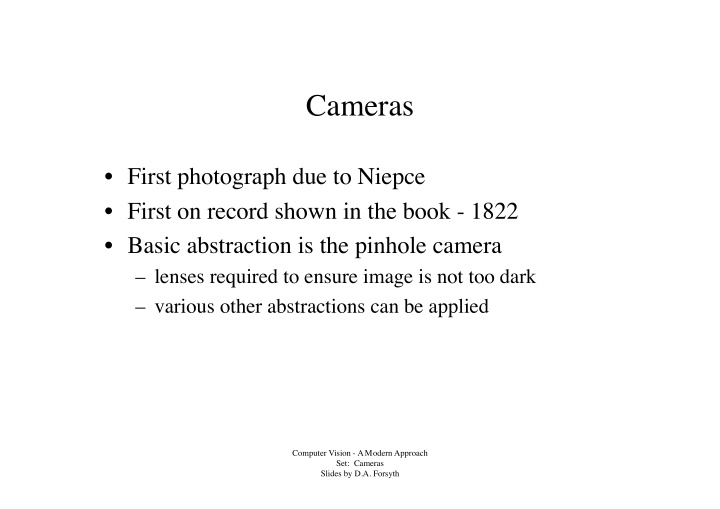



Cameras ! • ! First photograph due to Niepce ! • ! First on record shown in the book - 1822 ! • ! Basic abstraction is the pinhole camera ! – ! lenses required to ensure image is not too dark ! – ! various other abstractions can be applied ! Computer Vision - A Modern Approach ! Set: Cameras ! ! Slides by D.A. Forsyth
Image Formation ! • ! Optics (geometry) ! • ! Photometry (physics) ! Computer Vision - A Modern Approach ! Set: Cameras ! ! Slides by D.A. Forsyth
La “camera ottica” ! • ! Conosciuta sin dall’antichita’ (Aristotele ne accenna l’esistenza nel 330 a.C.), e’ l’antenato della moderna macchina fotografica ! Computer Vision - A Modern Approach ! Set: Cameras ! ! Slides by D.A. Forsyth
Camere oscure negli USA ! Computer Vision - A Modern Approach ! Set: Cameras ! ! Slides by D.A. Forsyth
Camera Obscura, Reinerus Gemma- Frisius, 1544 ! Computer Vision - A Modern Approach ! Set: Cameras ! ! Slides by D.A. Forsyth
Camera Obscura, Athanasius Kircher, 1646 ! Computer Vision - A Modern Approach ! Set: Cameras ! ! Slides by D.A. Forsyth
• ! Camera oscura a ! • ! San Francisco ! Computer Vision - A Modern Approach ! Set: Cameras ! ! Slides by D.A. Forsyth
Computer Vision - A Modern Approach ! Set: Cameras ! ! Slides by D.A. Forsyth
Camere oscure nel mondo … ! Computer Vision - A Modern Approach ! Set: Cameras ! ! Slides by D.A. Forsyth
… e in Italia (Rocca di Sanvitale, Fontanellato, Parma) ! Computer Vision - A Modern Approach ! Set: Cameras ! ! Slides by D.A. Forsyth
Pinhole cameras ! • ! Abstract camera model - • ! Pinhole cameras work in box with a small hole in it ! practice ! Computer Vision - A Modern Approach ! Set: Cameras ! ! Slides by D.A. Forsyth
The equation of projection ! Computer Vision - A Modern Approach ! Set: Cameras ! ! Slides by D.A. Forsyth
The equation of projection ! • ! Cartesian coordinates: ! – ! We have, by similar triangles, that (x, y, z) -> (f x/z, f y/z, -f) ! – ! Ignore the third coordinate, and get ! Computer Vision - A Modern Approach ! Set: Cameras ! ! Slides by D.A. Forsyth
Geometric properties of projection ! • ! Points go to points ! • ! Lines go to lines ! • ! Planes go to whole image ! Polygons go to polygons ! • ! • ! Degenerate cases ! – ! line through focal point to point ! – ! plane through focal point to line ! Computer Vision - A Modern Approach ! Set: Cameras ! ! Slides by D.A. Forsyth
Polyhedra project to polygons ! • ! (because lines project to lines) ! Computer Vision - A Modern Approach ! Set: Cameras ! ! Slides by D.A. Forsyth
Parallel lines converge ! Computer Vision - A Modern Approach ! Set: Cameras ! ! Slides by D.A. Forsyth
Distant objects are smaller ! Computer Vision - A Modern Approach ! Set: Cameras ! ! Slides by D.A. Forsyth
Orthographic projection ! Computer Vision - A Modern Approach ! Set: Cameras ! ! Slides by D.A. Forsyth
Pinhole too big - ! many directions are ! averaged, blurring the ! image ! Pinhole too small- ! diffraction effects blur ! the image ! Generally, pinhole ! cameras are dark , because ! a very small set of rays ! from a particular point ! hits the screen. ! Computer Vision - A Modern Approach ! Set: Cameras ! ! Slides by D.A. Forsyth
The reason for lenses ! Computer Vision - A Modern Approach ! Set: Cameras ! ! Slides by D.A. Forsyth
Thin lenses ! Computer Vision - A Modern Approach ! Set: Cameras ! ! Slides by D.A. Forsyth
Computer Vision - A Modern Approach ! Set: Cameras ! ! Slides by D.A. Forsyth
Basic radiometry ! Computer Vision - A Modern Approach ! Set: Cameras ! ! Slides by D.A. Forsyth
Computer Vision - A Modern Approach ! Set: Cameras ! ! Slides by D.A. Forsyth
Cameras ! Computer Vision - A Modern Approach ! Set: Cameras ! ! Slides by D.A. Forsyth
Digital images ! Computer Vision - A Modern Approach ! Set: Cameras ! ! Slides by D.A. Forsyth
Recommend
More recommend